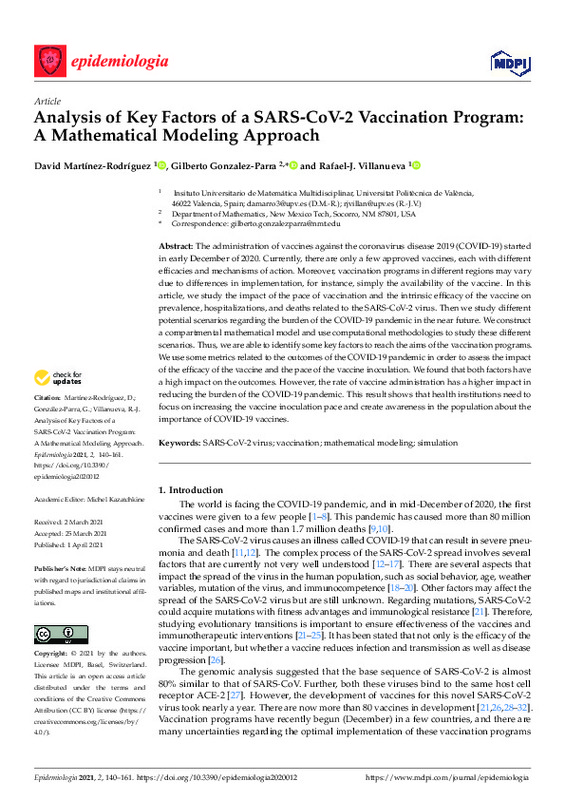JavaScript is disabled for your browser. Some features of this site may not work without it.
Buscar en RiuNet
Listar
Mi cuenta
Estadísticas
Ayuda RiuNet
Admin. UPV
Analysis of Key Factors of a SARS-CoV-2 Vaccination Program: A Mathematical Modeling Approach
Mostrar el registro sencillo del ítem
Ficheros en el ítem
| dc.contributor.author | Martínez-Rodríguez, David
|
es_ES |
| dc.contributor.author | González Parra, Gilberto
|
es_ES |
| dc.contributor.author | Villanueva Micó, Rafael Jacinto
|
es_ES |
| dc.date.accessioned | 2022-02-18T19:02:11Z | |
| dc.date.available | 2022-02-18T19:02:11Z | |
| dc.date.issued | 2021-04-01 | es_ES |
| dc.identifier.uri | http://hdl.handle.net/10251/180977 | |
| dc.description.abstract | [EN] The administration of vaccines against the coronavirus disease 2019 (COVID-19) started in early December of 2020. Currently, there are only a few approved vaccines, each with different efficacies and mechanisms of action. Moreover, vaccination programs in different regions may vary due to differences in implementation, for instance, simply the availability of the vaccine. In this article, we study the impact of the pace of vaccination and the intrinsic efficacy of the vaccine on prevalence, hospitalizations, and deaths related to the SARS-CoV-2 virus. Then we study different potential scenarios regarding the burden of the COVID-19 pandemic in the near future. We construct a compartmental mathematical model and use computational methodologies to study these different scenarios. Thus, we are able to identify some key factors to reach the aims of the vaccination programs. We use some metrics related to the outcomes of the COVID-19 pandemic in order to assess the impact of the efficacy of the vaccine and the pace of the vaccine inoculation. We found that both factors have a high impact on the outcomes. However, the rate of vaccine administration has a higher impact in reducing the burden of the COVID-19 pandemic. This result shows that health institutions need to focus on increasing the vaccine inoculation pace and create awareness in the population about the importance of COVID-19 vaccines. | es_ES |
| dc.description.sponsorship | Funding support from the National Institute of General Medical Sciences (P20GM103451) via NM-INBRE is gratefully acknowledged by the second author | es_ES |
| dc.language | Inglés | es_ES |
| dc.publisher | MDPI AG | es_ES |
| dc.relation.ispartof | Epidemiologia | es_ES |
| dc.rights | Reconocimiento (by) | es_ES |
| dc.subject | SARS-CoV-2 virus | es_ES |
| dc.subject | Vaccination | es_ES |
| dc.subject | Mathematical modeling | es_ES |
| dc.subject | Simulation | es_ES |
| dc.subject.classification | MATEMATICA APLICADA | es_ES |
| dc.title | Analysis of Key Factors of a SARS-CoV-2 Vaccination Program: A Mathematical Modeling Approach | es_ES |
| dc.type | Artículo | es_ES |
| dc.identifier.doi | 10.3390/epidemiologia2020012 | es_ES |
| dc.relation.projectID | info:eu-repo/grantAgreement/NIGMS//P20 GM103451/ | es_ES |
| dc.rights.accessRights | Abierto | es_ES |
| dc.contributor.affiliation | Universitat Politècnica de València. Instituto Universitario de Matemática Multidisciplinar - Institut Universitari de Matemàtica Multidisciplinària | es_ES |
| dc.contributor.affiliation | Universitat Politècnica de València. Departamento de Matemática Aplicada - Departament de Matemàtica Aplicada | es_ES |
| dc.description.bibliographicCitation | Martínez-Rodríguez, D.; González Parra, G.; Villanueva Micó, RJ. (2021). Analysis of Key Factors of a SARS-CoV-2 Vaccination Program: A Mathematical Modeling Approach. Epidemiologia. 2(2):140-161. https://doi.org/10.3390/epidemiologia2020012 | es_ES |
| dc.description.accrualMethod | S | es_ES |
| dc.relation.publisherversion | https://doi.org/10.3390/epidemiologia2020012 | es_ES |
| dc.description.upvformatpinicio | 140 | es_ES |
| dc.description.upvformatpfin | 161 | es_ES |
| dc.type.version | info:eu-repo/semantics/publishedVersion | es_ES |
| dc.description.volume | 2 | es_ES |
| dc.description.issue | 2 | es_ES |
| dc.identifier.eissn | 2673-3986 | es_ES |
| dc.identifier.pmid | 35141702 | es_ES |
| dc.identifier.pmcid | PMC8824484 | es_ES |
| dc.relation.pasarela | S\432727 | es_ES |
| dc.contributor.funder | National Institute of General Medical Sciences, EEUU | es_ES |








